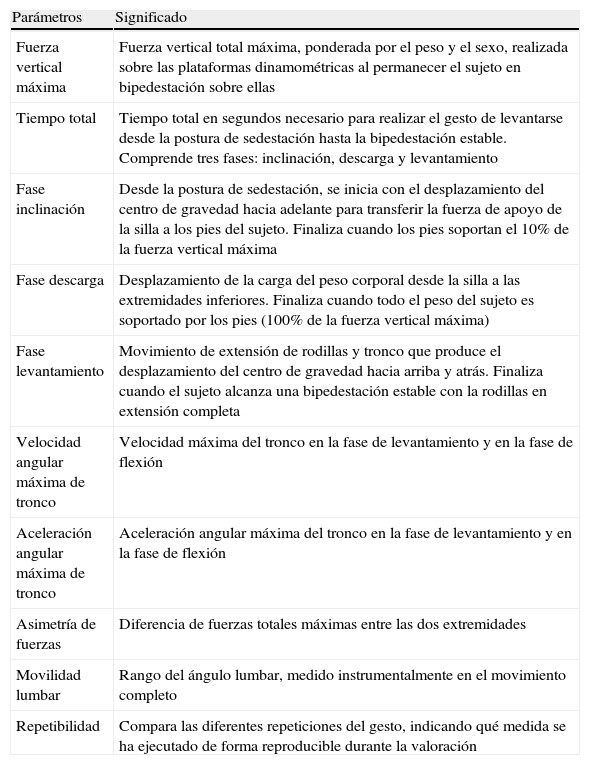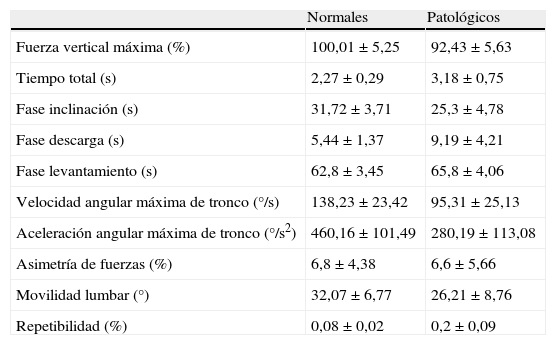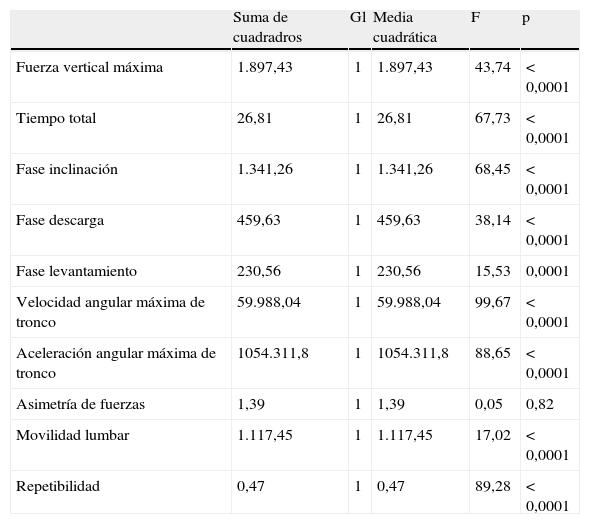La valoración de los pacientes con lumbalgia puede verse influida por factores psicosociales y laborales. Para mejorar el diagnóstico de estos pacientes es necesario disponer de parámetros clínicos objetivos. La finalidad de este trabajo es la valoración funcional instrumentada, mediante fotogrametría y plataformas de fuerza, de los sujetos con lumbalgia y la obtención de los patrones de movimiento correspondientes a los sujetos normales y con afección lumbar.
Material y métodosSe analiza el gesto de levantarse de una silla en 51 sujetos sanos y en 90 pacientes con dolor lumbar crónico. Se efectúa un análisis de la varianza de los parámetros obtenidos con un intervalo de confianza para la media del 95% y con un nivel de significación de p<0,05.
ResultadosLa fuerza vertical máxima normalizada desarrollada por los sujetos normales (100,01%) fue superior a la de los sujetos con lumbalgia (92,43%). El tiempo utilizado por los pacientes con dolor lumbar crónico (3,18 s) fue superior al de los sujetos sanos (2,27 s). Esta prolongación del tiempo se localiza, sobre todo, en la fase de descarga. Las diferencias encontradas, en estos parámetros, entre los dos grupos analizados son estadísticamente significativas (p<0,0001), permitiendo discriminar, de una manera objetiva, entre sujetos normales y con afección lumbar.
ConclusionesLa utilización de sistemas de valoración instrumental permite diferenciar objetivamente a los sujetos con afección lumbar de los sujetos sanos, siendo pues útiles como prueba médica complementaria.
Evaluation of patients with low back pain may be influenced by psychosocial and work-related issues. Objective clinical parameters are needed in order to improve the diagnosis of these patients. The aim of this work is to develop an instrumental functional assessment, using photogrammetry and force platforms, for subjects with lower back pain, and to obtain movement models both for normal subjects and for those with lumbar conditions.
Material and methodsThe «sit-to-stand» movement was analyzed in 51 healthy subjects and in 90 patients with chronic lower back pain. An analysis of the variance between the parameters obtained from the group of normal subjects and those suffering lower back pain, with a 95% confidence interval and a significance level of P<.05 was performed.
ResultsThe maximum normalized vertical force shown by the normal subjects (100.01%) was greater than that of those with lower back pain (92.43%). The time taken to perform the action by patients with chronic lower back pain (3.18 s) was greater than that by the healthy ones (2.27 s). This lengthening of time span is mainly found in the load-releasing phase. The differences found within these parameters, between the groups analyzed are statistically significant (P<.0001), thus making it possible for us to differentiate objectively between those who are healthy and those with lower back pain.
ConclusionsInstrumental functional assessment allows us to differentiate objectively between the subjects suffering lower back pain and those who are healthy. Therefore, they are useful as a complementary medical test.
Artículo
Comprando el artículo el PDF del mismo podrá ser descargado
Precio 19,34 €
Comprar ahora












